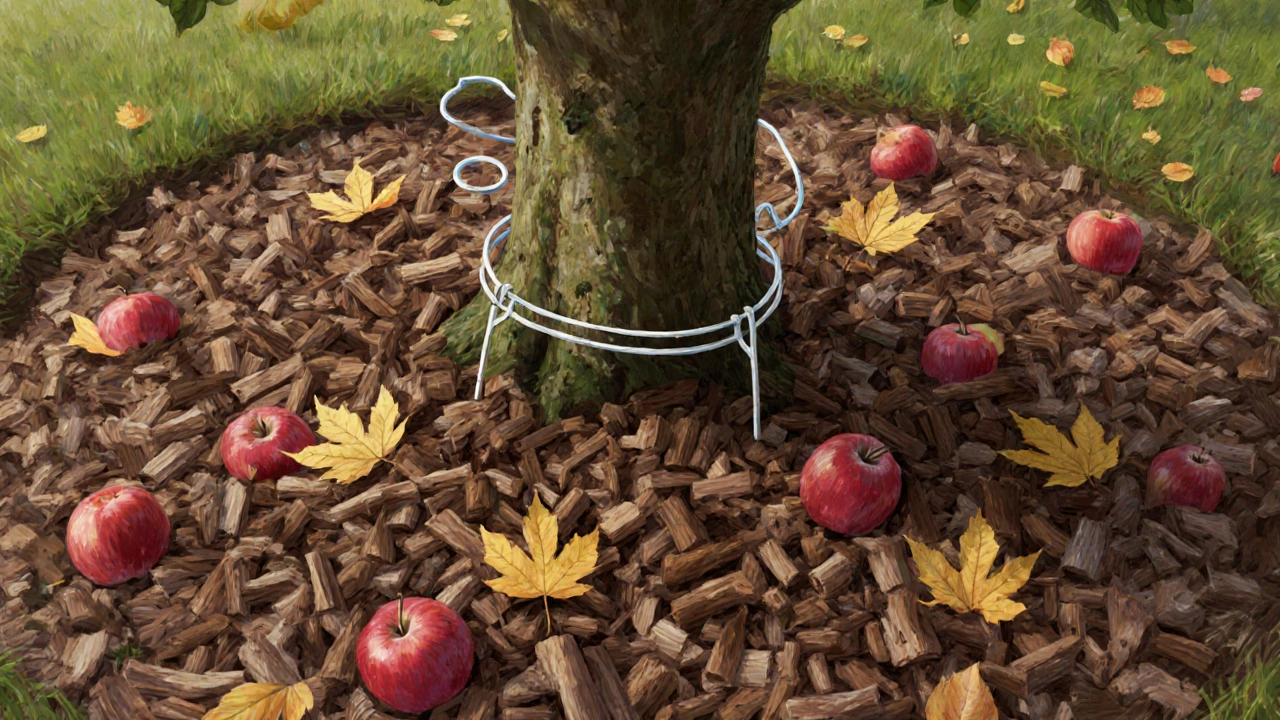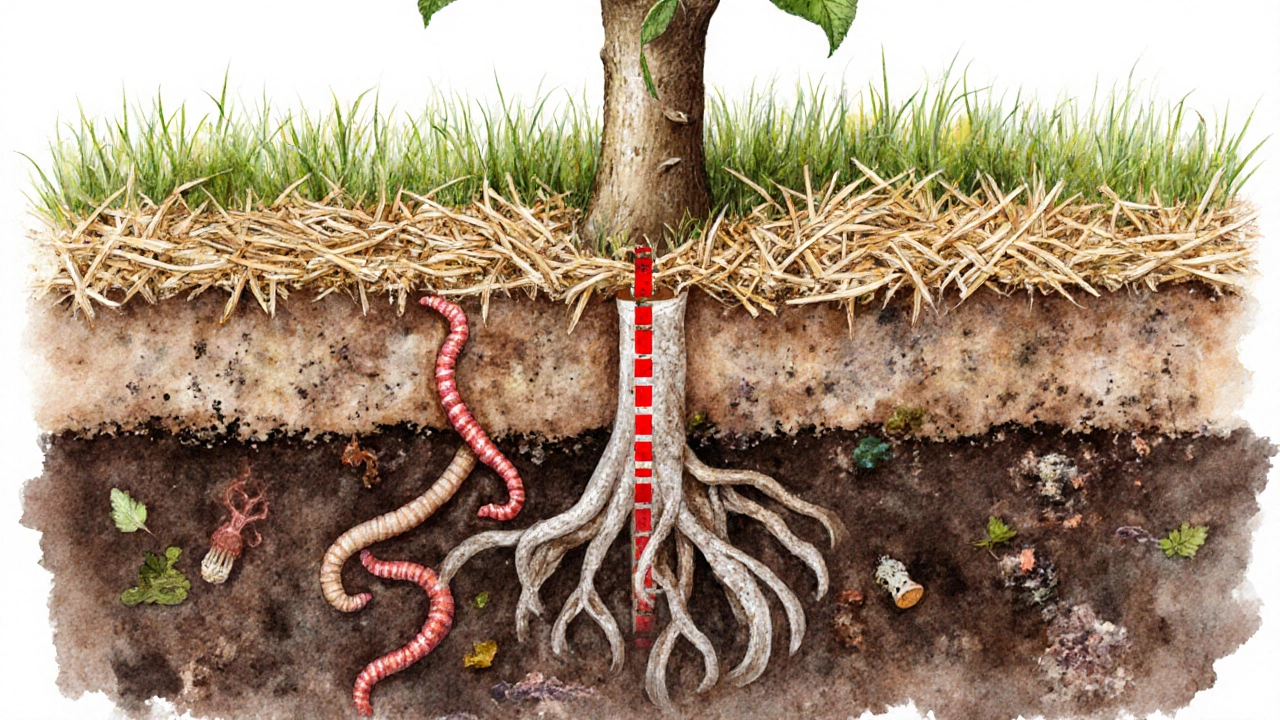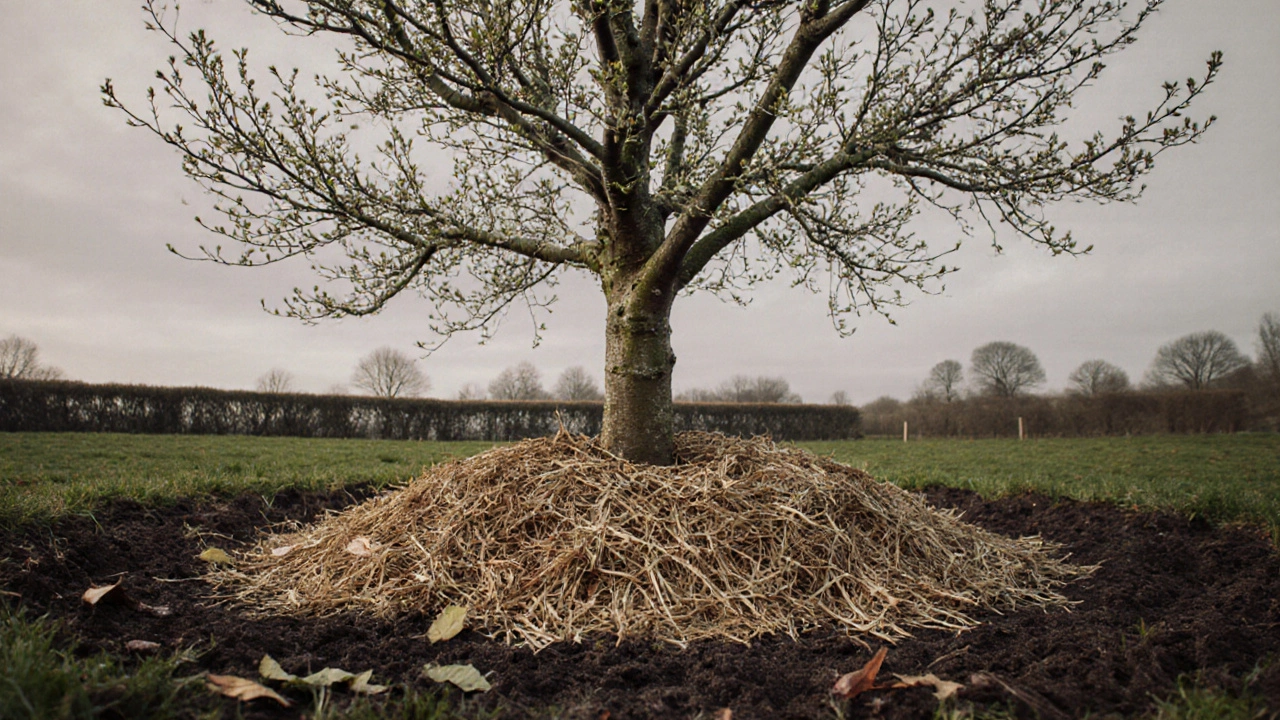Apple Tree Mulch Calculator
Calculate how much mulch you need for your apple tree based on the area around the base and desired depth.
Mulch Requirements
When you plant an apple tree in the UK, the ground around its base isn’t just empty soil-it’s the tree’s first line of defense. What you put there can mean the difference between a healthy, fruit-laden tree and one that struggles with weeds, drought, or rot. It’s not about fancy products or expensive gadgets. It’s about simple, smart choices that work with the seasons, the soil, and the climate you’re growing in.
Why the base of your apple tree matters
The area right around the trunk-called the root collar-is where your apple tree is most vulnerable. Too much moisture trapped against the bark? That invites fungal rot. Too many weeds stealing water and nutrients? Your tree won’t grow fast enough to bear fruit. Too much sun beating down on bare soil? The roots dry out, especially during dry springs and hot summers.
Apple trees in the UK don’t need constant attention, but they do need protection in their first three years. That’s when they’re most sensitive. A well-managed base helps them focus energy on growing strong roots and branches instead of fighting for survival.
What to use: mulch is the answer
The best thing to put around the base of an apple tree is mulch. Not gravel. Not plastic sheeting. Not wood chips straight from the garden centre without thinking. Real, natural mulch.
Organic mulch breaks down slowly, feeds the soil, keeps moisture in, and keeps weeds out. In the UK, where rain is common but so are dry spells, this balance is everything.
Here’s what works best:
- Straw - Light, easy to spread, and great for suppressing weeds. It lets water through and doesn’t pack down. Good for spring and early summer.
- Wood chips - Coarse, aged hardwood chips (not fresh pine or treated wood) last longer than straw. They’re ideal for autumn application. Avoid fine sawdust-it can form a crust and block water.
- Leaf mould - If you’ve collected fallen leaves over the winter and let them rot into dark, crumbly soil, this is gold. It’s rich in nutrients and perfect for early spring or late autumn.
- Compost - Well-rotted garden compost is excellent, but don’t pile it against the trunk. Use it as a thin layer under wood chips for extra nutrients.
Apply mulch in a circle around the tree, about 1 to 1.5 metres wide. Keep it 10-15 cm away from the trunk. That gap is non-negotiable. If mulch touches the bark, it holds moisture against it, and that’s how collar rot starts. You’ve seen it-the dark, soggy base of a tree that just… stops growing. That’s preventable.
When to apply mulch in the UK
Timing matters. In the UK, seasons shift fast. You don’t want to mulch too early and get soaked by autumn rains, or too late and let weeds take over.
Best times:
- Early spring (March-April) - After the soil has warmed up a bit but before summer heat kicks in. This locks in moisture and stops weeds from germinating. If you planted your tree last autumn, this is your first mulch job.
- Autumn (October-November) - After leaf fall and before the coldest weather. Mulch here acts like insulation. It protects shallow roots from frost heave and keeps the soil temperature steadier through winter. In southern England, like Brighton, this is especially useful because winters can be wet and mild-perfect for fungal growth if the base stays damp.
Avoid mulching in mid-summer unless you’re dealing with extreme drought. The heat can bake the mulch and make it less effective. And never mulch when the soil is frozen-wait for it to thaw.
What NOT to put around your apple tree
Some things people think help-actually hurt.
- Gravel or stones - They reflect heat, dry out the soil, and make it harder for beneficial insects and fungi to thrive. They look neat, but they’re not good for tree health.
- Plastic sheeting or landscape fabric - It blocks air and water from reaching the roots. It also traps moisture against the trunk, encouraging rot. And when it breaks down, it leaves microplastics in your soil.
- Fresh grass clippings - They heat up as they decompose and can burn young roots. They also often contain herbicides if your lawn was treated.
- Manure straight from the farm - Fresh manure is too hot. It can burn roots and introduce weed seeds. Always use well-rotted composted manure if you’re adding it.
- Flowers or shrubs planted too close - The root zone of an apple tree extends far beyond its canopy. Competing plants steal water and nutrients. Keep the base clear for at least a metre.

How thick should the mulch layer be?
Five to ten centimetres is ideal. That’s about the height of a standard garden trowel when full.
Too thin (under 3 cm)? Weeds will push through. Too thick (over 15 cm)? Water can’t reach the roots, and the mulch may start to anaerobically decompose, creating a smelly, sour mess. You want it loose enough to breathe but dense enough to block light from reaching weed seeds.
Reapply mulch every year. Organic mulch breaks down, so you’ll need to top it up in spring. Don’t dig it in-just add a fresh layer on top. The worms and microbes will do the rest.
What about tree guards?
Mulch isn’t the only thing you need. If you’ve got rabbits, voles, or deer in your area, a tree guard is essential. These are plastic or wire spirals you wrap around the trunk to stop animals from chewing the bark.
But here’s the catch: never put a tree guard directly on the trunk without leaving space. If you wrap it tight and then pile mulch up against it, you’ve created a perfect hiding spot for rodents. They’ll burrow under the mulch, chew the bark, and you won’t even notice until it’s too late.
Use a tree guard, but keep mulch at least 10 cm away from the base. That way, you protect the trunk without inviting pests.
Real UK garden example: Brighton
In Brighton, the soil is often sandy or chalky. That means it drains fast in summer but can get waterlogged in winter. A good mulch layer helps both.
One gardener I know uses a mix: leaf mould in autumn, topped with straw in spring. She renews it every year. Her three apple trees-‘Bramley’s Seedling’, ‘Cox’s Orange Pippin’, and ‘Egremont Russet’-have been fruiting heavily for over a decade. No chemical sprays. No fertilisers. Just mulch, time, and patience.
It’s not magic. It’s basic soil care.

Common mistakes and how to fix them
Even experienced gardeners mess this up.
- Mistake: Mulch piled against the trunk. Fix: Pull it back. Use a stick or trowel to create a clear ring around the base. Imagine a donut shape, not a mound.
- Mistake: Using fresh wood chips. Fix: Let them sit for six months before using. Fresh chips rob nitrogen from the soil as they break down.
- Mistake: Mulching in winter. Fix: Wait until the soil warms in spring. Mulch in freezing soil traps cold and delays root activity.
- Mistake: Thinking mulch replaces watering. Fix: Mulch conserves water-it doesn’t replace it. Water deeply once a week in dry spells, especially in the first two years.
What about fertiliser?
You don’t need it-at least not at first. A good mulch layer feeds the soil naturally. In the first three years, your apple tree doesn’t need extra nutrients. Too much fertiliser pushes weak, leafy growth instead of strong roots and fruiting wood.
If your tree isn’t growing at all after three years, and the leaves are pale yellow, then test your soil. Most UK apple trees just need good mulch and time.
Final tip: Let nature do the work
The goal isn’t to control the base of your apple tree-it’s to support it. Mulch isn’t a barrier. It’s a bridge. It connects the tree to the soil life below: fungi, bacteria, earthworms, beetles. These are the real gardeners. Your job is to give them the conditions they need to thrive.
Put down the right mulch, leave space around the trunk, time it right, and forget about it for a while. Your apple tree will thank you with blossoms in spring and fruit in autumn.
Can I use bark chips around my apple tree?
Yes, but only if they’re aged hardwood chips-not fresh or softwood like pine. Fresh bark chips can tie up nitrogen in the soil as they break down, starving your tree. Let them sit for at least six months before using. Apply a 5-10 cm layer, keeping it 10 cm away from the trunk.
Should I remove mulch in winter?
No. Mulch actually helps protect roots from frost heave during winter. In the UK, leaving mulch in place through winter helps keep soil temperatures stable. Just make sure it’s not piled against the trunk. If it’s too thick, lightly rake it back to prevent rot.
Is straw better than wood chips for apple trees?
Both work well, but they serve different purposes. Straw is lighter, easier to spread, and breaks down faster-great for spring when you want to suppress weeds quickly. Wood chips last longer and are better for autumn, offering longer-lasting insulation. Many gardeners use straw in spring and wood chips in autumn for the best of both.
Can I use grass clippings as mulch?
Only if they’re dried and free of herbicides. Fresh clippings can heat up and burn roots. Even dried clippings can form a dense mat that blocks water. Use them sparingly, mixed with coarser materials like straw or leaves. Never pile them thickly around the trunk.
How often should I replace the mulch?
Once a year, in early spring. Organic mulch breaks down over time, so you’ll need to top it up. Don’t dig it out-just add a fresh 5 cm layer on top. Over time, the old mulch will integrate into the soil and improve its structure.
